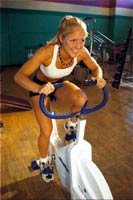In many sports, a high level of aerobic fitness is necessary for optimal performance because it promotes endurance and assists recovery in "stop-and-go" type sports, such as ice hockey.
To improve aerobic fitness, coaches have traditionally prescribed long and tedious sessions of continuous sub-maximal exercise for athletes, regardless of their sport-specific metabolic demands.
Most team sports are not characterized by continuous sub-maximal movement speeds, but rather these sports demand periods of high-intensity effort interspersed with maximal bursts of speed and periods of almost complete inactivity.
Take soccer for example, a player may move at a moderate speed for minutes while following the play and then will be forced to sprint at their maximal pace for the ball. After that, the player could be faced with a stoppage in play of up to a minute due to various factors.
Considering the endless possibilities, is long-duration, moderate-intensity aerobic training the best method of conditioning these types of athletes? In my opinion it is not. What then are the alternatives?
Let us consider "Aerobic Interval (AI) Training" as a more beneficial manner at increasing the aerobic fitness and sport-specific muscular endurance of an athlete in a "stop-and-go" team sport.
Aerobic Interval (AI) Training
Aerobic interval training provides a more sport-specific training intensity; a greater training stimulus that can be applied to the muscles used in the specific activities, and may also be an advanced training method for endurance training athletes looking to overcome a plateau in their aerobic fitness levels.
The intensity level of this training technique is much higher than the intensity level commonly associated with aerobic training. The exercise stimulus may in fact be damaging to the muscle in its initial attempts, and can result in muscle soreness in the days following the training session.
Therefore, prior to beginning a "full-blown" training regimen of AI's, the athlete should develop general muscular strength and endurance and perform a short "lead-in" program of general aerobic exercise (2 weeks; 3 sessions per week; 20 minutes; high-intensity; sport-specific activity).
The initial (first week; 2 sessions) AI training sessions should be conservative in training volume (3-5 intervals) to accustom the muscles and joints to the intensity. As well, a thorough and specific warm-up should be performed as well as pre- and post-exercise flexibility routines.
AI training involves alternating bouts of exercise with recovery periods. A sport-specific mode of exercises is performed for a short duration (2-5 minutes) and followed by an equal length rest interval. High-intensity work is the key factor in this type of training.
By incorporating rest intervals, the athlete can work at a much higher (and more sport-specific) power output in comparison to traditional aerobic training.
Determining Intensity
Determining the intensity of the exercise bout is definitely the trickiest component of the training prescription. The "work" pace should elicit the individual's maximal heart rate by the end of the exercise bout. For example, if a 20-year-old athlete (max HR = ~200) ran a 3-minute interval then their 10-second heart rate count should be ~33 beats (33 x 6 = 198) at the end of exercise.
Calculate Your Maximum Heart Rate Here
An example distance for a 3-minute running interval would be ~800m. Basically, the athlete wants to pick a training intensity that they believe they could hold constant for up to 10 minutes.
Obviously, picking the intensity can be very subjective unless the facility has "high-tech" training equipment. As the AI intensity should correspond to about 95-100% of the individual's VO2 max, if the athlete has access to high-tech training technology then a more accurate training prescription may be allowed.
Providing an adequate and complete rest interval is paramount! The rest interval must be of an extremely low-intensity so that sufficient recovery will occur, and the next work interval can again be performed at a high power output. Do not sacrifice the quality of rest because this will only reduce the benefit of AI training.
A reduced recovery will prevent lactate clearance (lactate = muscle fatigue), phosphate energy (CP & ATP) recovery, and improvements in aerobic metabolism. Remember, this is not continuous training!
Many athletes that have traditionally trained with only long, slow distance workouts may have difficulty with this concept at the outset of the program; however these athletes will soon become more comfortable taking a full-length recovery interval.
At ~2 minutes of maximal exercise, the contribution of the anaerobic & aerobic energy systems are nearly equal, and at 5 minutes, the contribution is 30% anaerobic & 70% aerobic. Therefore, the high-intensity, short-duration nature of AI allows sport-specific demands to be applied.
Training at such a high-intensity recruits the fast-twitch muscle fibers. These fibers are predominantly responsible for anaerobic performance, but by improving the aerobic system of these fibers, they will be able to recover quicker and be ready to contribute to sprint-performance with less rest time.
The adaptations in the body will be occurring predominantly at the muscle level. The muscle fibers will increase their ability to extract and use oxygen, but the improvements on oxygen delivery (heart and lung adaptations) may be minimal.
The athlete will also improve their ability to tolerate lactate (lactic acid buildup in the muscle and blood) and will be ready to start Anaerobic Interval training in the pre-season.
Anaerobic Intervals
Anaerobic intervals match precisely the demands of the sport. For example, a hockey anaerobic interval would be maximal exercise for 30-45 seconds followed by 1-3 minutes of recovery.
An anaerobic interval training prescription needs to be addressed in, and deserves, an article of its own—perhaps in the near future ... (Stay tuned.)
Aerobic Intervals
Aerobic Interval Training Prescription:
- Tip 1. Do 2-3 minutes warm-up and equal recovery time.
- Tip 2. Progress up to 10-12 intervals.
- Tip 3. At 95-100% of VO2 max, do 8-10 minute pace. (But don't go too hard!)
- Tip 4. End with approximately MaxHR by end of interval.
Fluids should be available at all times throughout the training session to help combat dehydration. Unfortunately, many athletes may not feel comfortable consuming a high-volume of water or sports drinks while undergoing this intensity of training.
To compensate, ensure adequate pre-hydration (make it a habit to drink sufficient fluids daily) and excess post-exercise fluid intake.
The athlete should use AI to train the body to consume fluids during rest intervals of competition. Remember the importance of being well-hydrated (dehydration can cause a reduction in endurance).
Warning
Your legs will feel like Jello upon completion of this workout for the first time! The muscle glycogen (carbohydrate energy) stores will be extremely depleted, and muscle fatigue will be high also due to lactate accumulation.
Therefore, take caution in the scheduling of the remainder of your training day and the following day because of reduced neuromuscular coordination and fatigue.
However, full recovery should occur within 24-48 hours. Make sure to consume a high-carbohydrate snack immediately after exercise, and to maintain a diet with sufficient carbohydrate foods and fluids.
Therefore, AI training should occur in a sport-specific manner. The intensity and duration of the intervals should increase in specificity as the pre-season draws closer. Therefore, AI's train the body to perform repeated intervals of high-power outputs, with the end result being an increase in sport performance!




